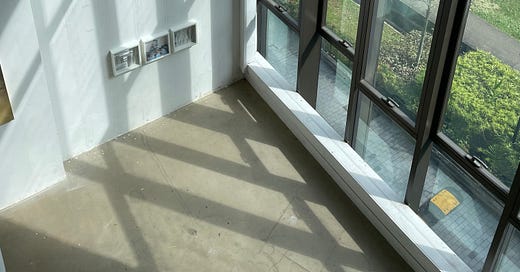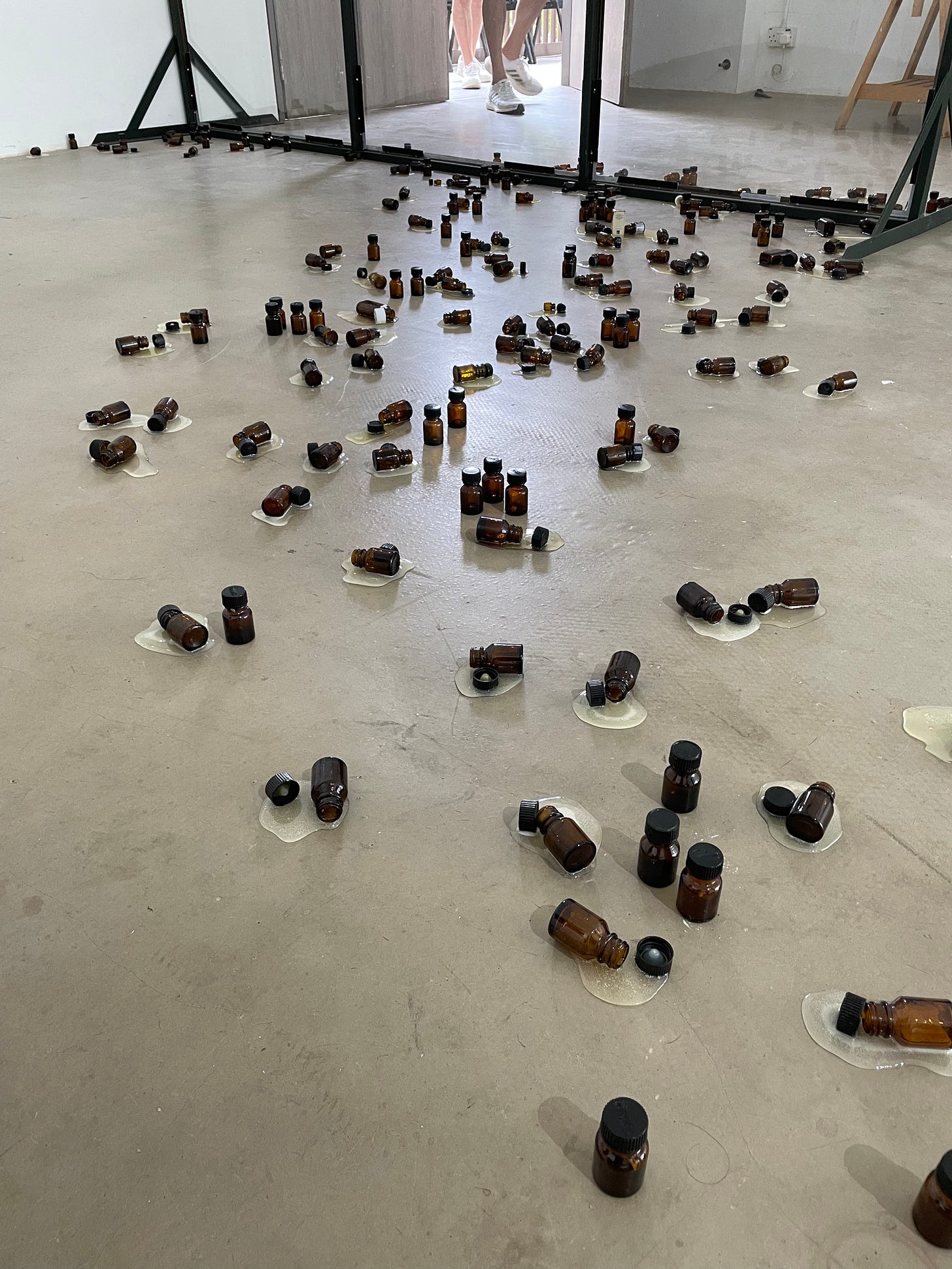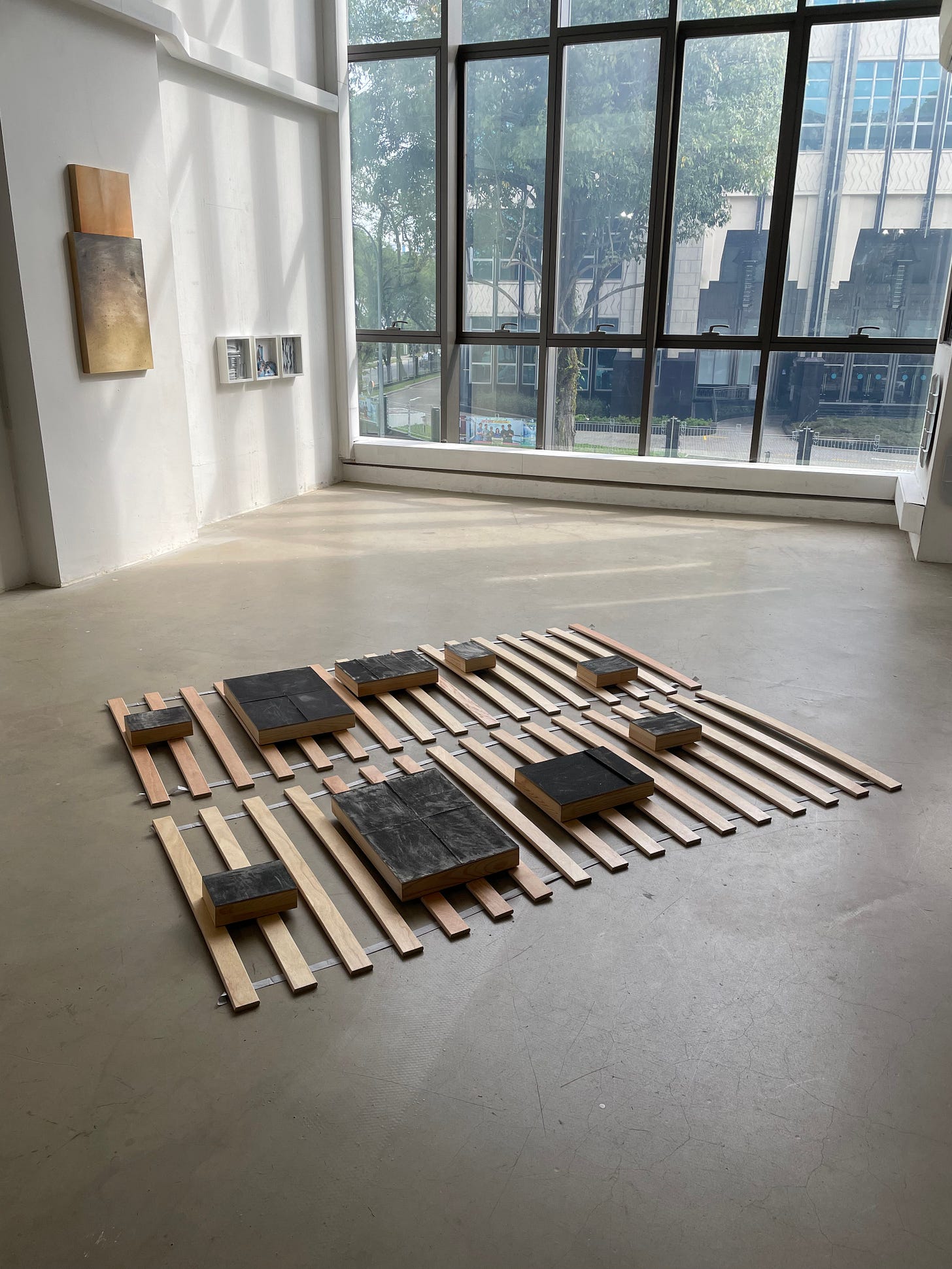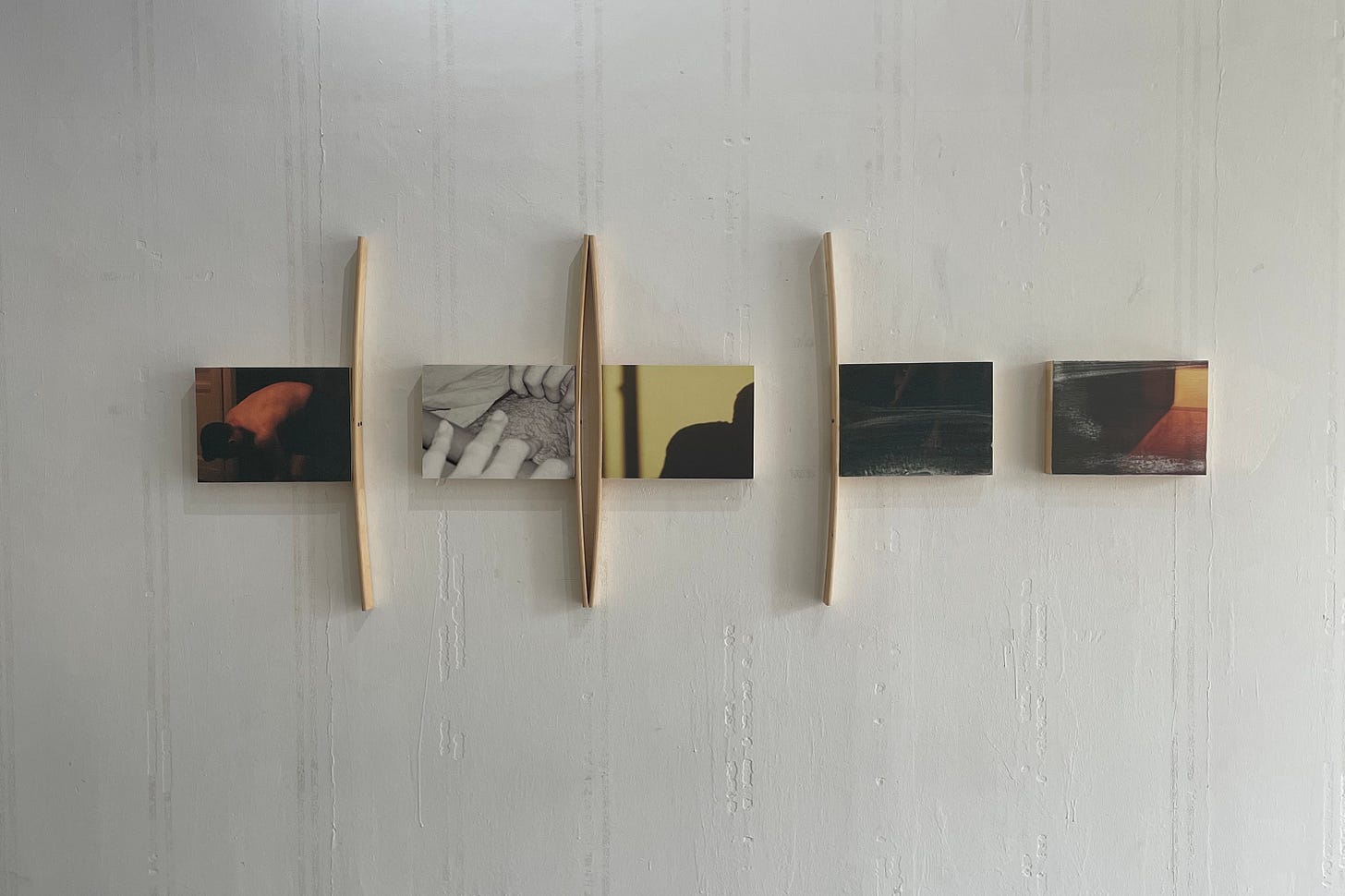The first thing I’ll say about desiring sanctuary is that getting there was hell.
I remember getting off the bus stop at Upper Thomson Road only to be surrounded by towering forestry, its patterns of green so indiscernible that I had a hard time reorienting myself. This was followed by a twelve-minute walk up the slope of an industrial area, and I trudged through an eerily barren space with the occasional truck roaring past just to keep me on my toes. And all this under the sweltering heat!
Thoughts flooded my mind as I tried to distract myself from the tension in my legs: How am I still not there yet? Am I even in the right place? It thus felt serendipitous that my woes were echoed by the exhibition that awaited me at Starch: desiring sanctuary, a duo show by artists Dylan Chan and Ezzam Rahman, and curated by Regina De Rozario.
Entering the exhibition felt like stepping into a crime scene. Immediately, my path was disrupted by Ezzam Rahman’s fv<k me, a cluster of poppers bottles scattered on the floor and even seeping into the reception area, with liquid spilling out in small puddles that imply their sloppy consumption, possibly while seeking ecstasy or relief from a weary daily routine. Ezzam further channels his experiences with exhaustion into i’m hurt when you say it out loud, another cluster of found objects installed further into the space. This time, it features tubes of analgesic balm that appear thoroughly squeezed out of capacity, their contents expelled in forms so obscenely violent that the lingering tensions that permeate these objects become palpable and even confrontational, despite their narrative role as part of an unwinding aftermath. Here, the climax has passed, leaving us with only the objects that carried its remnants, and our attempts at gaining clarity on the situation only further obscure the reality of the past with layers of inference and interpretation.
Considering Ezzam’s status as a middle-aged queer man, I can’t help but think of this aspect of his work as possibly referencing his own phase in life as “past his prime”. With popular queer media typically showcasing relationships amongst queer youths, queerness is usually depicted as part of someone’s coming-of-age, but very little light is shone on queer life in one’s later years, since they’re supposedly no longer maturing, but ageing. Ezzam’s works are thus deeply confessional as they appear to explore his struggle with his age through his experiences with self-care: are these drugs only meant to relieve us of present pains, or do we hope that they’ll bring us back to our rose-tinted “glory days”?
The exhibition’s overarching theme of objects as a vessel for memory is realised in a more tender, metaphorical sense through Dylan Chan’s portrayals of queer intimacy. Tiptoeing around Ezzam’s floor installations led me to Your/My side of the bed, Dylan’s installation consisting of two ladders of wooden slats laid on the floor, with an arrangement of wooden blocks layered on top that mimic the poses of two resting human figures, with their lower bodies pointing towards each other in a moment of deconstructed romance. It’s interesting to note the sheets of used sandpaper affixed onto the top faces of the wooden blocks: as the sandpaper captures the traces of friction and pressure through its changes in colour, its use in context speaks to how our bodies are marked by conflicts we might have with our loved ones, yet it is exactly through these moments of discord that we become closer with one another. This idea is bolstered by Dylan’s use of wood pieces as well, as the wood is used in the making of bed frames which simultaneously support and add tension due to their contact with human weight.
While Ezzam’s found objects leave past hypotheticals hanging, Dylan’s wall installations lay bare the tensions that lie within the realities of queer lives. Consisting of photos printed and affixed onto wooden blocks, sometimes framed by curved wooden slats that emphasise their corporeality, Dylan’s sculptures surround the space as fragile bodies left exposed. Yet at the same time, so much information is being withheld: the photos themselves are heavily cropped and processed as if to juxtapose the revealing nature of their content.
The use of the curved wooden slats here is curious as they support the liminality captured in Dylan’s photography, sometimes defining and other times striking through. In fact, the slats’ resemblance to parentheses symbols suggests a poetic aspect to Dylan’s works, as our own bodies can be interpreted as sites for narratives to unfold. Particularly in Happy together (I’m glad we decided to stay), the slats do not frame the entirety of the work, with a pair of slats bracketing nothing at all. As Dylan processes the transient fragments of life spent with his partner through the sense-making nature of language, I wonder if this could be a critique at the finality of established queer narratives, such as the reality of “coming out”, life after transitioning, and especially queer struggles in a post-377A Singapore. After all, should a queer person be expected to finish growing into oneself, when even non-queer individuals are constantly confronted with conflict throughout their lives? Are all queer concerns miraculously solved after the repeal of one law?
For Ezzam Rahman, however, language is a means to explore his particular struggles with care work. they are just words that you can’t relate takes place at the staircase leading up to the second floor, featuring small wooden panels tiled with used muscle relief patches, with each panel containing a word written in Jawi script relating to themes of exhaustion (e.g. “work”, “money”, “disappointment”), as well as a few strands of Ezzam’s own hair. Though even without reading the words, I could empathise with its message — while climbing up the staircase, I once again felt that tension in my legs. Recalling my arduous journey to the exhibition, I wondered if the choice to exhibit at Starch was also made for this reason.
Nevertheless, the difference in accessibility really mattered when I reached the top. Waiting at the second floor was a similarly-themed wooden panel attached to the wall, this time circular. Written on it is a homophobic slur, which would have really felt like a slap in the face if I were able to intuitively read the script. But being able to read it is not necessarily the point: the obscuring of meaning through language speaks to the distancing of its user, and my inability to access the language only highlights the alienation faced by Ezzam due to his intersecting identities as both queer and Muslim.
It’s strangely comforting to see a contemporary exhibition venue like Starch reimagined as an intermediately domestic realm, where rarely explored topics in the queer community are given the space to breathe. As Dylan, Ezzam, and Regina carve out a precious couple of weeks for us to contemplate our relationships with space in a city that lacks it (as well as infrastructure that effectively uses what exists of it), desiring sanctuary makes me hopeful that I just might get there in the end, despite the hell of it all.










lovely review!!!!! thankyou for sharing your words with us🥹